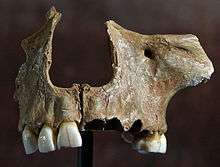List of human evolution fossils
| Part of a series on |
| Paleontology |
|---|
 |
|
Organs and processes |
|
History of paleontology |
|
Branches of paleontology |
|
Paleontology Portal Category |
The following tables give a brief overview of several notable hominin fossil finds relating to human evolution beginning with the formation of the Hominini tribe in the late Miocene (roughly 6 million years ago).
As there are thousands of fossils, mostly fragmentary, often consisting of single bones or isolated teeth with complete skulls and skeletons rare,[1] this overview is not complete, but does show some of the most important finds. The fossils are arranged by approximate age as determined by radiometric dating and/or incremental dating and the species name represents current consensus; if there is no clear scientific consensus the other possible classifications are indicated. Deprecated classifications may be found on the fossil's page.
Most of the fossils shown are not considered direct ancestors to Homo sapiens but are closely related to direct ancestors and are therefore important to the study of the lineage.
Late Miocene
5.5 million - 7 million years old
| Name | Age | Species | Year discovered |
Country | Discovered by | Now located at | |
|---|---|---|---|---|---|---|---|
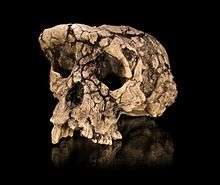 |
TM 266 (Toumai) | 7 Ma[2] | Sahelanthropus tchadensis | 2001 | Chad | Alain Beauvilain, Fanone Gongdibe, Mahamat Adoum and Ahounta Djimdoumalbaye | N'Djamena (Chad), BEAC |
| BAR 1000'00 | 6 Ma[3] | Orrorin tugenensis | 2000 | Kenya | Martin Pickford, Kiptalam Cheboi, Dominique Gommery, Pierre Mein, Brigitte Senut, | ||
| ALA-VP 1/20[4] | 5.5-5.8 Ma | Ardipithecus kadabba | 1997 | Ethiopia | Yohannes Haile-Selassie |
Pliocene
2.58 million - 5.3 million years old
Pleistocene
Lower Paleolithic: 400,000 - 2.58 million
Middle Paleolithic: 300,000 - 50,000 years old
Upper Paleolithic: 50,000 - 10,000 years old
Holocene
Mesolithic / Neolithic: 10,000 - 5000 years old
| Name | Age | Species | Year discovered |
Country | Discovered by | Now located at | |
|---|---|---|---|---|---|---|---|
 |
La Brea Woman | ~ 10k | Homo sapiens sapiens | 1914 | United States | ||
 |
Combe Capelle | 9.6 k[113] | Homo sapiens sapiens | 1909 | France | O. Hauser | |
 |
Cheddar Man | 9k | Homo sapiens sapiens | 1903 | UK | ||
 |
Kow Swamp 1 | 9k - 13k | Homo sapiens sapiens | 1968 | Australia | A.G. Thorne | |
| Afalou 13 | 8k - 12k | Homo sapiens sapiens | 1920 | Algeria | C. Arambourg | ||
| Wadi Halfa (Site 6B36) | 8k - 15k | Homo sapiens sapiens | 1963 | Sudan | G. Armelagos, E. Ewing, D. Greene | ||
| Wadi Kubbaniya | 8k - 20k | Homo sapiens sapiens | 1982 | Egypt | Fred Wendorf | ||
 |
Minnesota Woman | 7.8 - 8k | Homo sapiens sapiens | 1931 | Minnesota, United States | Albert Jenks, via construction crew | |
| Lo 4b[114][115] | 6k - 9k | Homo sapiens sapiens | 1965-1975 | Kenya | H. Robbins B.M. Lynch | ||
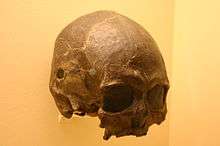 |
Tepexpan man | 5k - 11k | Homo sapiens sapiens | 1947 | Mexico | H. de Terra | |
| Del Mar skull | 4.9k - 11.8 | Homo sapiens sapiens | 1929 | United States | M.J. Rogers | ||
 |
Ötzi | 5.3k | Homo sapiens sapiens | 1991 | Ötztal Alps, Italy | Helmut Simon and Erika Simon |
Abbreviations used in fossil catalog name
- AL – Afar Locality, Ethiopia
- ARA-VP – Aramis Vertebrate Paleontology, Ethiopia
- BAR – (Lukeino, Tugen Hills) Baringo District, Kenya
- BOU-VP – Bouri Vertebrate Paleontology, Ethiopia
- D – Dmanisi, Georgia
- ER – East (Lake) Rudolf, Kenya
- KGA – Konso-Gardula, Ethiopia
- KNM – Kenya National Museum
- KP – Kanapoi, Kenya
- LB – Liang Bua, Indonesia
- LH – Laetoli Hominid, Tanzania
- MH – Malapa Hominin, South Africa
- NG – Ngandong, Indonesia
- OH – Olduvai Hominid, Tanzania
- SK – Swartkrans, South Africa
- Sts, Stw – Sterkfontein, South Africa
- TM – Transvaal Museum, South Africa
- TM – Toros-Menalla, Chad
- WT – West (Lake) Turkana, Kenya
Timelines
Orange labels: known ice ages.
Also see: Human timeline and Nature timeline
See also
- Dawn of Humanity (2015 PBS film)
- Human evolution
- List of countries and islands by first human settlement
- List of fossil primates
- List of fossil sites
- List of notable fossils
- List of transitional fossils
- Most recent common ancestor
- Nature timeline
- Paleoanthropology
- Prehistoric Autopsy (2012 BBC documentary)
- Timeline of human evolution
Further reading
- Gibbons, Ann. The First Human: The Race to Discover our Earliest Ancestor. Anchor Books (2007). ISBN 978-1-4000-7696-3
- Hartwig, Walter (ed.). The Primate Fossil Record. Cambridge University Press (2002). Reprinted 2004. ISBN 978-0-521-08141-2.
- Johanson, Donald & Wong, Kate. Lucy's Legacy: The Quest for Human Origins. Three Rivers Press (2009). ISBN 978-0-307-39640-2
- Jones, Steve; Martin, Robert D.; Pilbeam, David R (Editors). (1994). The Cambridge Encyclopedia of Human evolution. Cambridge University Press. ISBN 978-0-521-46786-5 (Note: this book contains very useful, information dense chapters on primate evolution in general, and human evolution in particular, including fossil history).
- Leakey, Richard & Lewin, Roger. Origins Reconsidered: In Search of What Makes us Human. Little, Brown and Company (1992). ISBN 0-316-90298-5
- Lewin, Roger. Bones of Contention: Controversies in the Search for Human Origins. Penguin Books (1987). ISBN 0-14-022638-9
- Morwood, Mike & van Oosterzee, Penny. A New Human: The Startling Discovery and Strange Story of the 'Hobbits' of Flores, Indonesia. Smithsonian Books (2007). ISBN 978-0-06-089908-0
- Oppenheimer, Stephen. Out of Eden: The Peopling of the World. Constable (2003). ISBN 1-84119-697-5
- Roberts, Alice. The Incredible Human Journey: The Story of how we Colonised the Planet. Bloomsbury (2009). ISBN 978-0-7475-9839-8
- Shreeve, James. The Neanderthal Enigma: Solving the Mystery of Modern Human Origins. Viking (1996). ISBN 0-670-86638-5
- Stringer, Chris. The Origin of Our Species. Allen Lane (2011). ISBN 978-1-84614-140-9
- Stringer, Chris & Andrews, Peter. The Complete World of Human Evolution. Thames & Hudson (2005). ISBN 0-500-05132-1
- Stringer, Chris & McKie, Robin. African Exodus: The Origins of Modern Humanity. Jonathan Cape (1996). ISBN 0-224-03771-4
- van Oosterzee, Penny. The Story of Peking Man. Allen & Unwin (1999). ISBN 1-86508-632-0
- Walker, Allan & Shipman, Pat. The Wisdom of the Bones: In Search of Human Origins. Weidenfeld and Nicholson (1996). ISBN 0-297-81670-5
- Wade, Nicholas. Before the Dawn: Recovering the Lost History of our Ancestors. Penguin Press (2006). ISBN 978-0-7156-3658-9
- Weiss, M.L., & Mann, A.E. (1985). "'Human Biology and Behaviour: An anthropological perspective" (4th ed.). Boston: Little Brown. ISBN 978-0-673-39013-4 (Note: this book contains very accessible descriptions of human and non-human primates, their evolution, and fossil history).
- Wells, Spencer (2004). The Journey of Man : A Genetic Odyssey. New York, NY: Random House Trade Paperbacks. ISBN 978-0-8129-7146-0.
References
- ↑ "Prominent Hominid Fossils". Retrieved 2006-08-31.
- ↑ "Fossil Hominids: Toumai". Talkorigins.org. 2002-07-31. Retrieved 2012-10-15.
- ↑ "Bar 10200'". Smithsonian National Museum of Natural History. Retrieved 2012-07-27.
- ↑ "Ardipithecus kadabba". efossils. Retrieved 26 March 2015.
- ↑ Amos, Jonathan (2009-10-01). "Fossil finds extend human story". BBC News.
- ↑ I. A. N., McDougall; Craig, Feibel (1999). "Numerical age control for the Miocene-Pliocene succession at Lothagam, a hominoid-bearing sequence in the northern Kenya Rift". Journal of the Geological Society. 156: 731–745. doi:10.1144/gsjgs.156.4.0731.
- 1 2 3 Hill, Andrew; Ward, Steven (1988). "Origin of the Hominidae: the record of African large hominoid evolution between 14 My and 4 My". Yearbook of Physical Anthropology. 31 (59): 49–83. doi:10.1002/ajpa.1330310505.
- ↑ Patterson B, Behrensmeyer AK, Sill WD (June 1970). "Geology and fauna of a new Pliocene locality in north-western Kenya". Nature. 226 (5249): 918–21. PMID 16057594. doi:10.1038/226918a0.
- ↑ Lothagam mandible fragment
- ↑ Ward, Steven; Hill, Andrew. "Pliocene hominid partial mandible from Tabarin, Baringo, Kenya". American Journal of Physical Anthropology. 72 (1): 21–37. PMID 3103460. doi:10.1002/ajpa.1330720104.
- ↑ Heslip, Steven (2001). "Australopithecus anamensis". Archived from the original on June 8, 2011.
- ↑ "Oldupai". Ntz.info. Retrieved 2012-10-15.
- ↑ KNM-WT 40000
- ↑ Smithsonian
- ↑ "http://www.sciencedaily.com/releases/2015/05/150527134040.htm". www.sciencedaily.com. Retrieved 2015-05-28. External link in
|title=(help) - ↑ http://www.modernhumanorigins.net/al444-2.html Image at Modern Human Origins
- ↑ http://www.eurekalert.org/multimedia/pub/87535.php Image at Eurekalert
- ↑ http://www.eurekalert.org/pub_releases/2015-03/asu-doj022715.php Press Release
- ↑ "Australopithecus garhi: BOU-VP-12/130". efossils. Retrieved 13 June 2016.
- ↑ http://travelmag.co.uk/?p=1254
- ↑ "Archived copy". Archived from the original on 2006-01-18. Retrieved 2006-07-11. Image at Modern Human Origins
- ↑ http://humanorigins.si.edu/evidence/human-fossils/fossils/sts-71 Image at Smithsonian
- ↑ http://www.modernhumanorigins.net/sts52.html Image at Modern Human Origins
- ↑ Department of Anthropology: The University of Texas at Austin. "Paranthropus robustus: TM 1517". Retrieved 2014-06-09.
- ↑ http://www.scientificamerican.com/article.cfm?id=south-african-hominin-fossil MH1 image at Scientific American
- ↑ Juliet King (June 4, 2010). "Australopithecus sediba fossil named by 17-year-old Johannesburg student". Origins Centre. Archived from the original on March 25, 2012. Retrieved 2011-07-09.
- ↑ Jonathan, Amos (2011-09-08). "African fossils put new spin on human origins story". http://www.sciencemag.org/site/extra/sediba/index.xhtml. BBC News. Retrieved 9 September 2011. External link in
|work=(help) - ↑ Mai, L.L., Owl, M.Y., & Kersting, M.P. (2005), p.286
- ↑ http://humanorigins.si.edu/evidence/3d-collection/oh-24 Image at Smithsonian
- ↑ http://www.modernhumanorigins.net/oh8.html OH 8 image of foot at Modern Human Origins
- 1 2 3 Leakey MG, Spoor F, Dean MC, et al. (August 2012). "New fossils from Koobi Fora in northern Kenya confirm taxonomic diversity in early Homo". Nature. 488 (7410): 201–4. PMID 22874966. doi:10.1038/nature11322.F
- ↑ "Homo ergaster". Australian Museum. Retrieved July 7, 2014.
- ↑ Inverted strata
- ↑ Donald C. Johanson; Blake Edgar (1996). From Lucy to Language. New York, NY: Simon & Schuster. p. 158.
- ↑ http://humanorigins.si.edu/evidence/3d-collection/knm-er-23000 Image at Smithsonian
- ↑ Leakey, R. E. F. y Walker, A. C. (1988). "New Australopithecus boisei specimens from East and West Lake Turkana, Kenya". American Journal of Physical Anthropology. 76 (1): 1–24. ISSN 1096-8644. PMID 3136654. doi:10.1002/ajpa.1330760102.
- ↑ Grine, Frederick E., ed. (2007). Evolutionary History of the "Robust" Australopithecines. Transaction Publishers. pp. 99, 185–186, 247. ISBN 9780202365961. Retrieved 16 February 2015.
- 1 2 Wood, Bernard, ed. (2011). Wiley-Blackwell Encyclopedia of Human Evolution, 2 Volume Set. ISBN 9781444342475. doi:10.1002/9781444342499. Retrieved 11 May 2014. Access to the references of this book.
- ↑ http://www.modernhumanorigins.net/stw53.html STW 53 image at Modern Human Origins
- ↑ http://www.modernhumanorigins.net/sk847.html SK 847 image at Modern Human Origins
- ↑ http://www.modernhumanorigins.net/dnh7.html DNH 7 image at Modern Human Origins
- ↑ http://humanorigins.si.edu/evidence/human-fossils/fossils/sk-46 Image at Smithsonian
- ↑ http://www.modernhumanorigins.net/oh9.html Chellean OH 9 Image at Modern Human Origins
- ↑ Wood, Bernard A.; Constantino, Paul J. (28 November 2007). "Paranthropus boisei: Fifty Years of Evidence and Analysis" (PDF). Yearbook of Physical Anthropology. Biological Sciences Faculty Research. 50: 109–110. PMID 18046746. doi:10.1002/ajpa.20732. Retrieved 27 July 2015.
- ↑ Smithsonian National Museum of Natural History. "Konso KGA10-525". What does it mean to be human?. Retrieved 17 February 2015.
- ↑ Michael Hopkin (March 26, 2008). "Fossil find is oldest European yet". Nature News. doi:10.1038/news.2008.691.
- ↑ "Dating the Homo erectus bearing travertine from Kocabas (Denizli, Turkey) at at least 1.1 Ma". Earth and Planetary Science Letters. 390: 8–18. Bibcode:2014E&PSL.390....8L. doi:10.1016/j.epsl.2013.12.031.
- ↑ Kappelman, J; Alçiçek, MC; Kazanci, N; Schultz, M; Ozkul, M; Sen, S (January 2008). "FirstHomo erectus from Turkey and implications for migrations into temperate Eurasia". American Journal of Physical Anthropology. 135: 110–116. PMID 18067194. doi:10.1002/ajpa.20739.
- ↑ http://humanorigins.si.edu/evidence/human-fossils/fossils/trinil-2 Image at Smithsonian
- ↑ "Ternifine or Tighenif". Retrieved 28 March 2015.
- ↑ http://www.modernhumanorigins.net/sangiran17.html Sangiran 17 image at Modern Human Origins
- ↑ http://archive.archaeology.org/9809/newsbriefs/eritrea.html
- ↑ http://www.modernhumanorigins.net/bodo.html Bodo image at Modern Human Origins
- ↑ https://www.msu.edu/~heslipst/contents/ANP440/images/Saldanha.JPG Saldanha man Archived July 11, 2007, at the Wayback Machine.
- ↑ http://www.modernhumanorigins.net/pa830.html Hexian PA830 image at Modern Human Origins
- ↑ Peter Brown. "Hexian". Peter Brown's Australian & Asian Palaeoanthropology. Retrieved 2014-05-18.
- ↑ Eric Delson, Ian Tattersall, John Van Couvering, Alison S. Brooks, eds. (2004). Encyclopedia of Human Evolution and Prehistory: Second Edition. Routledge. p. 624. ISBN 9781135582289. Retrieved 9 August 2015.
- ↑ Smithsonian National Museum of Natural History. "Salé". What does it mean to be human?. Retrieved 18 May 2014.
- ↑ J. J. Jaeger (1975). "The mammalian faunas and hominid fossils of the Middle Pleistocene of the Maghreb". In K.W.Butzer & G.Ll.Isaac. After the Australopithecines. Den Hage. pp. 399–418. ISBN 978-9027976291.
- ↑ http://humanorigins.si.edu/evidence/3d-collection/ndutu Image at Smithsonian
- ↑ https://elifesciences.org/content/6/e24231
- ↑ http://humanorigins.si.edu/evidence/3d-collection/petralona-1 Smithsonian's Human Origins Program
- ↑ http://www.thelocal.it/20151104/italy-dates-its-first-neanderthal-to-250k-years-ago
- ↑ http://www.modernhumanorigins.net/dali.html Dali image at Modern Human Origins
- ↑ P. Brown Dali archaic Homo Sapiens
- ↑ Chen, T; Yang, Q; Wu, E (1994). "Antiquity of Homo sapiens in China". Nature. 368: 55–56. doi:10.1038/368055a0.
- ↑ http://www.modernhumanorigins.net/omo1.html Omo 1 Image at Modern Human Origins
- ↑ http://www.modernhumanorigins.net/omo2.html Omo II Image at Modern Human Origins
- ↑ Chang, C.-H.; Kaifu, M.; Kona, R. T.; Grün, R.; Matsu'ura, S.; Kinsley, L.; Lin, L.-K. (2015). "First archaic Homo from Taiwan". Nature Communications. 6: 6037. PMC 4316746
 . PMID 25625212. doi:10.1038/ncomms7037.
. PMID 25625212. doi:10.1038/ncomms7037. - ↑ Choi, Charles Q. (January 27, 2015). "Ancient Human Fossil Could Be New Primitive Species". Live Science.
- ↑ McMenamin, M. A. S. (2015). Homo tsaichangensis and Gigantopithecus. South Hadley, Massachusetts: Meanma. ISBN 1-893882-19-5. doi:10.13140/2.1.3463.7121.
- ↑ http://www.abc.net.au/science/news/stories/s877478.htm Herto skull images at ABC Science
- ↑ David Richter et al. (8 June 2017). "The age of the hominin fossils from Jebel Irhoud, Morocco, and the origins of the Middle Stone Age". Nature. 546: 293–296. Retrieved 8 June 2017.
- ↑ Smith TM, Tafforeau P, Reid DJ, et al. (April 2007). "Earliest evidence of modern human life history in North African early Homo sapiens". Proceedings of the National Academy of Sciences of the United States of America. 104 (15): 6128–33. PMC 1828706
 . PMID 17372199. doi:10.1073/pnas.0700747104.
. PMID 17372199. doi:10.1073/pnas.0700747104. - ↑ Image of Altamura Man
- ↑ Image of Altamura Man skull
- ↑ Martina Lari, Fabio Di Vincenzo, Andrea Borsato, Silvia Ghirotto, Mario Micheli, Carlotta Balsamo, Carmine Collina, Gianluca De Bellis, Silvia Frisia, Giacomo Giacobini, Elena Gigli, John C. Hellstrom, Antonella Lannino, Alessandra Modi, Alessandro Pietrelli, Elena Pilli, Antonio Profico, Oscar Ramirez, Ermanno Rizzi, Stefania Vai, Donata Venturo, Marcello Piperno, Carles Lalueza-Fox, Guido Barbujani, David Caramelli, Giorgio Manzi (2015). "The Neanderthal in the karst: First dating, morphometric, and paleogenetic data on the fossil skeleton from Altamura (Italy)". Journal of Human Evolution. 82: 88–94. PMID 25805042. doi:10.1016/j.jhevol.2015.02.007.
- ↑ http://www.modernhumanorigins.net/tabun1.html Tabun 1 Image at Modern Human Origins
- ↑ Zimmer, Carl (16 November 2015). "In a Tooth, DNA From Some Very Old Cousins, the Denisovans". New York Times. Retrieved 16 November 2015.
- ↑ Sawyer, Susanna; Renaud, Gabriel; Viola, Bence; Hublin, Jean-Jacques; Gansauge, Marie-Theres; Shunkov, Michael V.; Derevianko, Anatoly P.; Prüfer, Kay; Kelso, Janet; Pääbo, Svante (11 November 2015). "Nuclear and mitochondrial DNA sequences from two Denisovan individuals". PNAS. Bibcode:2015PNAS..11215696S. doi:10.1073/pnas.1519905112. Retrieved 16 November 2015.
- ↑ "Archived copy". Archived from the original on 2007-09-27. Retrieved 2007-03-20. Krapina C Images at Modern Human Origins
- 1 2 3 4 5 6 7 8 9 Smith TM, Tafforeau P, Reid DJ, et al. (December 2010). "Dental evidence for ontogenetic differences between modern humans and Neanderthals". Proceedings of the National Academy of Sciences of the United States of America. 107 (49): 20923–8. PMC 3000267
 . PMID 21078988. doi:10.1073/pnas.1010906107.
. PMID 21078988. doi:10.1073/pnas.1010906107. - ↑ http://www.modernhumanorigins.net/qafzeh6.html Qafzeh VI images at Modern Human Origins
- ↑ Qafzeh IX Archived 2007-09-27 at the Wayback Machine.
- ↑ http://www.modernhumanorigins.net/klasies.html Klasies Images at Modern Human Origins
- ↑ Norton, Christopher J.; Braun, David R. Asian paleanthropology: From Africa to China and beyond. New York, NY: Springer. p. 107. ISBN 978-90-481-9093-5. doi:10.1007/978-90-481-9094-2.
- ↑ "What does it mean to be human?". Smithsonian National Museum of Natural History. Retrieved July 27, 2012.
- ↑ Johanson, Donald; Edgar, Blake (2006). From Lucy to Language. Simon & Schuster. ISBN 978-0-7432-8064-8.
- ↑ http://www.modernhumanorigins.net/amud7.html Amud 7 Image at Modern Human Origins
- 1 2 Demeter, F.; Shackelford, L. L.; Bacon, A.-M.; Duringer, P.; Westaway, K.; Sayavongkhamdy, T.; Braga, J.; Sichanthongtip, P.; Khamdalavong, P.; Ponche, J.-L.; Wang, H.; Lundstrom, C.; Patole-Edoumba, E.; Karpoff, A.-M. (2012). "Anatomically modern human in Southeast Asia (Laos) by 46 ka". Proceedings of the National Academy of Sciences. 109 (36): 14375–14380. PMC 3437904
 . PMID 22908291. doi:10.1073/pnas.1208104109.
. PMID 22908291. doi:10.1073/pnas.1208104109. - ↑ Demeter, Fabrice; Shackelford, Laura; Westaway, Kira; Duringer, Philippe; Bacon, Anne-Marie; Ponche, Jean-Luc; Wu, Xiujie; Sayavongkhamdy, Thongsa; Zhao, Jian-Xin; Barnes, Lani; Boyon, Marc; Sichanthongtip, Phonephanh; Sénégas, Frank; Karpoff, Anne-Marie; Patole-Edoumba, Elise; Coppens, Yves; Braga, José; Macchiarelli, Roberto (2015). "Early Modern Humans and Morphological Variation in Southeast Asia: Fossil Evidence from Tam Pa Ling, Laos". PLOS ONE. 10 (4): e0121193. PMC 4388508
 . PMID 25849125. doi:10.1371/journal.pone.0121193.
. PMID 25849125. doi:10.1371/journal.pone.0121193. - ↑ http://www.modernhumanorigins.net/amud1.html Amud 1 Image at Modern Human Origins
- ↑ "Human evolution: interpreting evidence". Museum of Science, Boston, US. Retrieved July 27, 2012.
- ↑ http://www.modernhumanorigins.net/circeo.html Mount Circeo 1 Image at Modern Human Origins
- ↑ http://www.modernhumanorigins.net/neanderthal1.html Neanderthal 1 images at Modern Human Origins
- ↑ http://news.softpedia.com/newsImage/Experts-Recreate-the-Face-of-the-First-European-2.jpg/ Images of Peştera cu Oase
- ↑ Timeline at Bone & Stone
- ↑ http://www.modernhumanorigins.net/predmosti3.html Predmosti 3 images at Modern Human Origins
- 1 2 Schulting RJ, Trinkaus E, Higham T, Hedges R, Richards M, Cardy B (May 2005). "A Mid-Upper Palaeolithic human humerus from Eel Point, South Wales, UK". Journal of Human Evolution. 48 (5): 493–505. PMID 15857652. doi:10.1016/j.jhevol.2005.02.001.
- ↑ http://www.modernhumanorigins.net/minatogawa1.html Minatogawa 1 images at Modern Human
- ↑ Template:Cita magazine
- ↑ "Lake Tandou Skull". Australia: The Land Where Time Began. Retrieved 2014-05-19.
- ↑ Stringer, C. B. (1985). "The hominid remains from Gough's Cave" (PDF). Proceedings of the University of Bristol Spelaeological Society. 17 (2): 145–52.
- ↑ McKie, Robin (June 20, 2010). "Bones from a Cheddar Gorge cave show that cannibalism helped Britain's earliest settlers survive the ice age". The Observer. Guardian. Retrieved 2012-10-15.
- ↑ "Mystery of a West African skull from 13,000 years ago". Natural History Museum, London, UK. Retrieved July 27, 2012.
- ↑ Johnson, John. "Arlington Man". National Park Service. Retrieved December 25, 2014.
- ↑ Leroy-Gourhan, Michel Brézillon ; preface by André (1969). Dictionnaire de la préhistoire (Ed. rev. & corr. ed.). Paris: Larousse. ISBN 2-03-075437-4.
- ↑ C. Smith (1999). "Who Was First? Untangling America's Prehistoric Roots". Discovery Communications Inc. Retrieved July 2, 2014.
- ↑ Bird, Junius B. (1988). "Four views of skull from skeleton 99.1/779". In Hyslop, John. Travels and Archaeology in South Chile. University of Iowa Press. p. 214. ISBN 978-1-58729-014-5.
- ↑ Travels and Archeology in South Chile. Cornell University, New York, U.S. Retrieved August 21, 2013.
- ↑ Storm, Paul; Nelson, Andrew (1992). "The many faces of Wadjak man". Archaeology in Oceania. 27 (1): 37–46. JSTOR 40386932. doi:10.1002/j.1834-4453.1992.tb00281.x.
- ↑ Allen, Jim. "The Curious History of the Talgai Skull". Bulletin of the History of Archaeology. Ubiquity Press. ISSN 2047-6930. Retrieved 3 June 2015.
- ↑ Seidler, Christoph (9 February 2011). "Forscher entzaubern Steinzeitmann". Der Spiegel (in German). Retrieved 2012-04-19.
- ↑ Powell, Joseph F. (2005). The First Americans: Race, Evolution and the Origin of Native Americans (Google Books). Cambridge University Press. pp. 169–170. ISBN 9780521530354. Retrieved 2015-01-25.
- ↑ Angel, J.L.; Phenice, T.W.; Robbins, L.H.; Lynch, B.M. (1980). Late stone age fishermen of Lothagam, Kenya. National Anthropological Archives, Sithsonian Institution, Part 3.
Bibliography
- Tattersall, Ian, Schwartz, Jeffery (2000). Extinct Humans. Westview Press, Boulder CO. ISBN 978-0-8133-3482-0.
- Larsen, Clark Spencer, Matter, Robert M, Gebo, Daniel L (1991). Human Origins: the fossil record. Waveland Press, Prospect Heights, IL. ISBN 978-0-88133-575-0.
- "Smithsonian Human Origins Program". Retrieved 2006-08-29.
- "Prominent Hominid Fossils". Retrieved 2006-08-31.
- Grine, F.E.; Jungers, W.L.; Schultz, J. (1996). "Phenetic Affinities Among Early Homo Crania from East and South Africa". Journal of Human Evolution. 30 (3): 189–225. doi:10.1006/jhev.1996.0019.
External links
- Interactive map of primate fossil finds around the world
- Informative lecture on Australopithecines
- The Age of Homo sapiens – Interactive Map of Human Evolution Fossils
- Human Timeline (Interactive) – Smithsonian, National Museum of Natural History (August 2016).


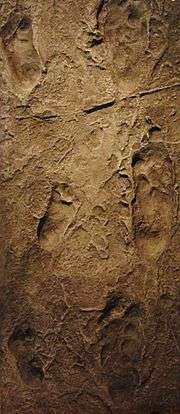









.jpg)
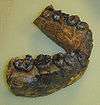
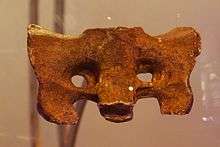


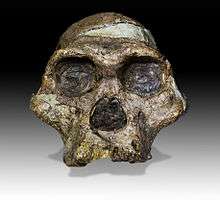
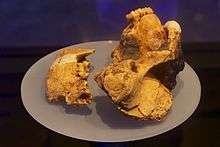



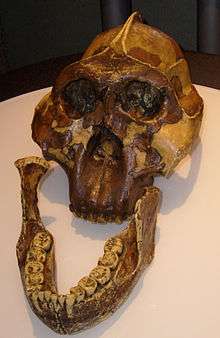
.jpg)


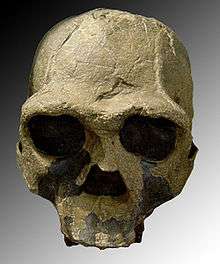




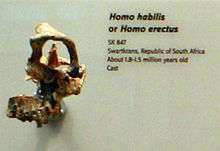

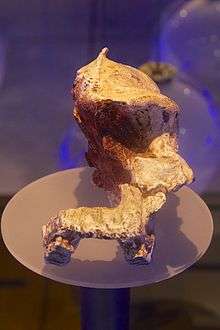




.jpg)

.jpg)

_presented_at_Paleozoological_Museum_of_China.jpg)







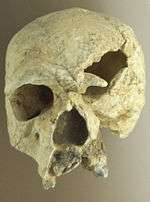
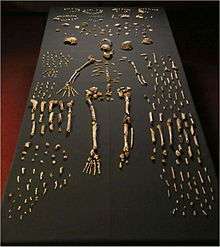

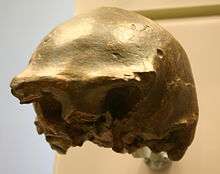

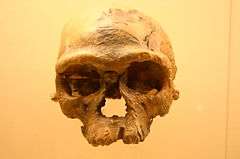

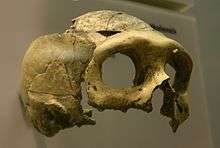






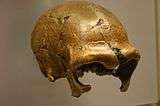

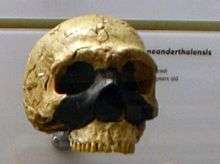








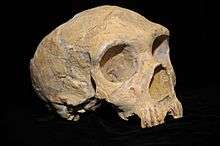

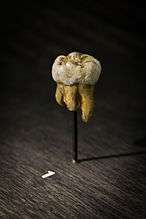
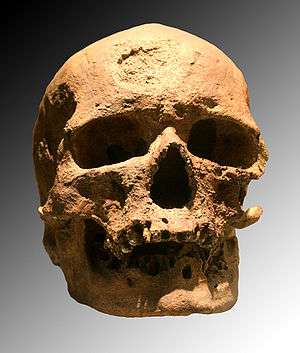
.jpg)


